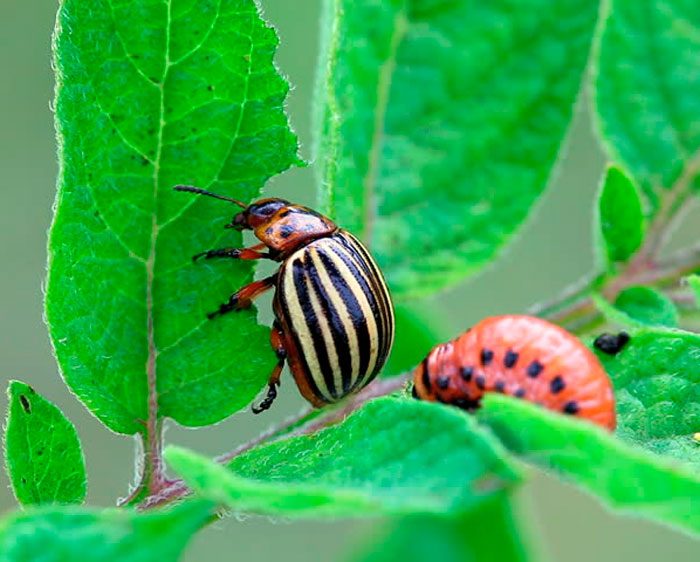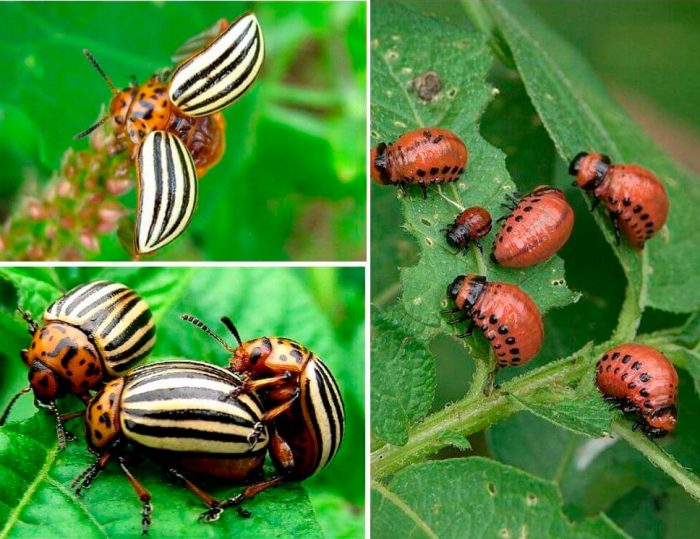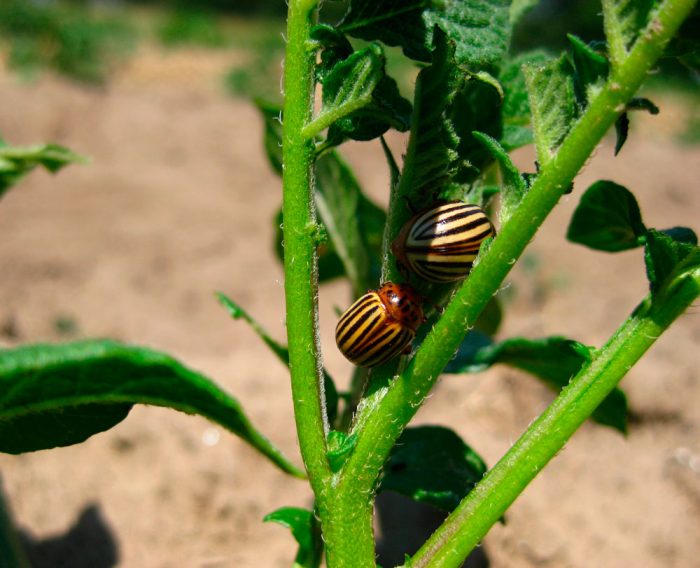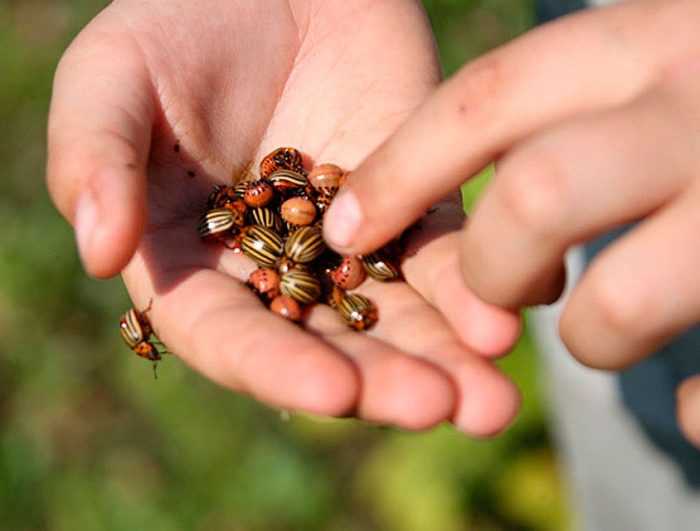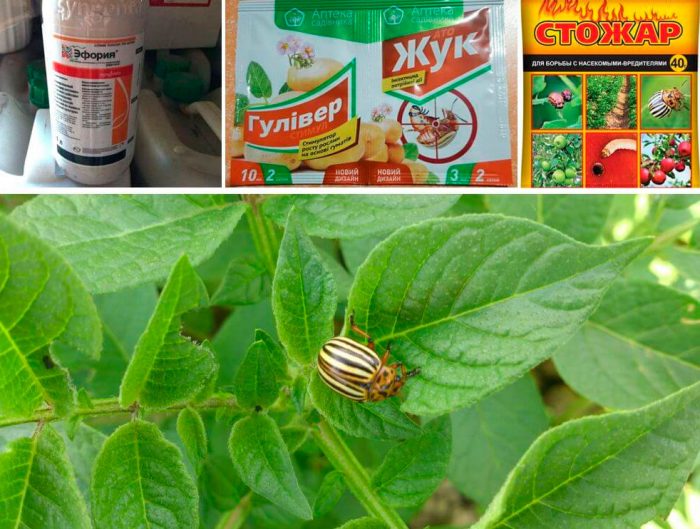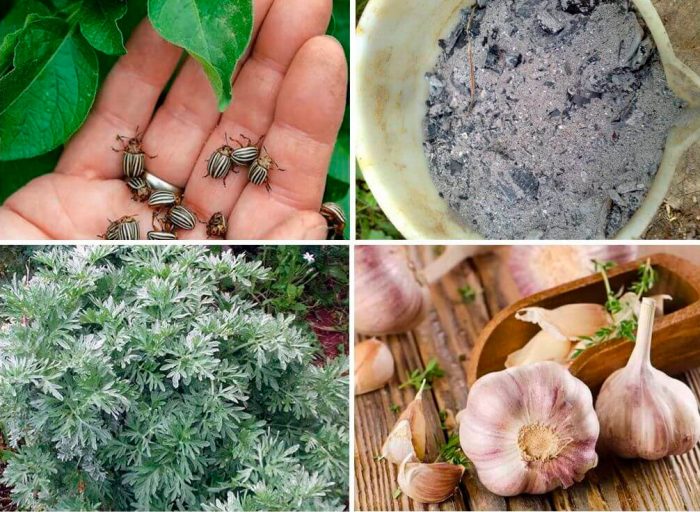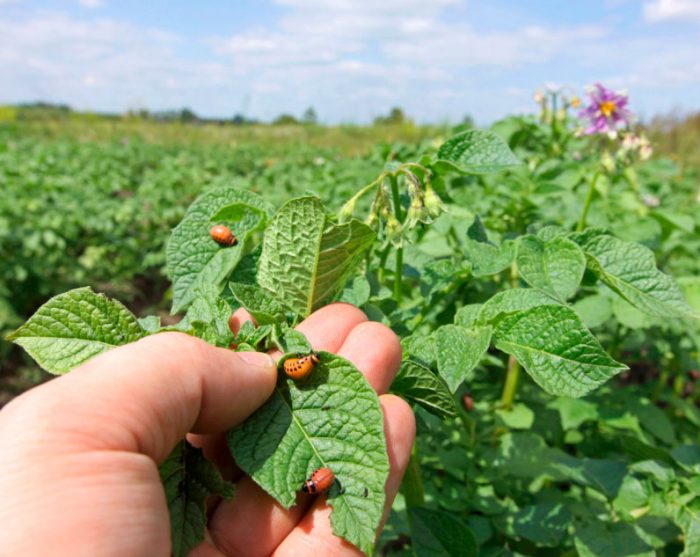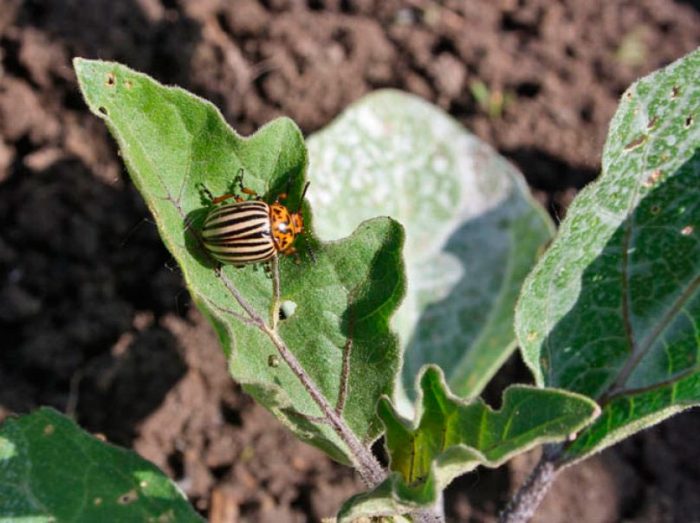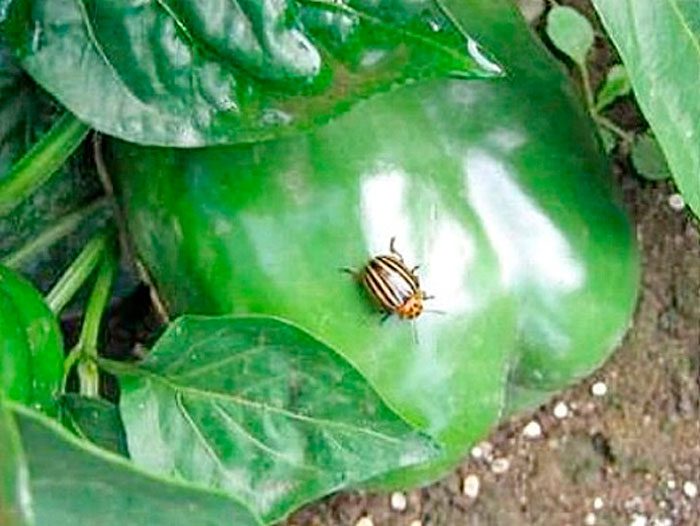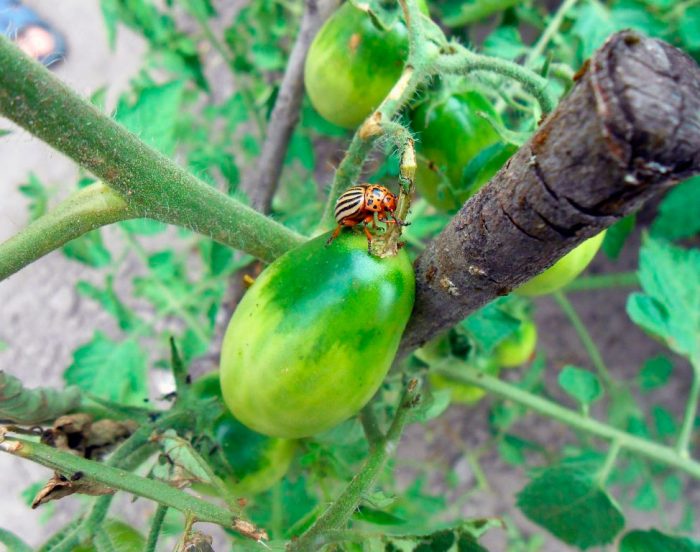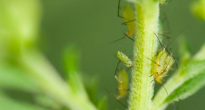The Colorado potato beetle insect (Leptinotarsa decemlineata) is a member of the leaf beetle family. It feeds on the foliage of plants belonging to the Solanaceae family, namely: eggplant, bell pepper, physalis, potato, tomato, henbane and wolfberry. In 1824, American naturalist and entomologist Tom Say, while describing insect specimens that he collected from horned nightshade in the Rocky Mountains, identified the Colorado potato beetle as a member of the genus Chrysomela. However, some time later, by the German Christian Wilhelm Souffrian, he was transferred to the genus Doryphora. Only in 1858 the Colorado potato beetle was included in the genus Leptinotarsa by the Swedish entomologist Stahl. The people called this beetle "Colorado" after in 1859, due to the invasion of this pest, the potato fields were devastated, and this happened in the state of Colorado.
The beetle is native to the northeastern part of Mexico, where you can meet other types of insects that eat the foliage of wild nightshade plants and tobacco. In 1876–1877, the beetle was found in the vicinity of Leipzig, where he got there along with trade goods, while he had to cross the Atlantic Ocean. He was quickly exterminated, but then brought back in ...
In France, this pest was able to gain a foothold in 1918, and from there it has already spread throughout European territory. Only in the UK the beetle could not take root.
Content
Features of the Colorado potato beetle
The Colorado potato beetle is an insect that has a glossy convex body of an oval shape, it is colored orange-yellow, its width is about 0.7 cm, and its length is from 0.8 to 1.2 cm.On the elytra there are five black stripes colors, and on the dorsum - specks of the same color. The beetle has well-developed membranous wings, thanks to which it can withstand long flights. The length of the larva of such a pest is 1.5–1.6 cm, its head is black, and on the sides there are a couple of rows of specks of the same shade. At first, the body of the larvae is colored dark brown, but after a while it changes to a pale pink or rich yellow hue. When the larvae eat the foliage, they digest absolutely all pigments, but not carotene.Over time, it accumulates in the tissues, due to which the body color becomes carrot.
For wintering, such an insect is buried in the ground to a depth of 0.2 to 0.5 meters, and in spring time it gets out to the surface of the earth and begins to eat young shoots, mate and lay eggs on the seamy surface of the foliage. During the day, only 1 female is able to lay 5–80 eggs, and during one season - 300–1000 eggs. The larvae of the first instar are on the seamy surface of the leaf and eat its pulp, the second instar - they eat the entire leaf, only the central vein remains from it, and the third and fourth instars can move to the bushes growing nearby. After 15–20 days, they are buried in the ground to a depth of about 10 centimeters, where they pupate. Within 1.5–3 weeks, the larvae become adults, after which they crawl out to the surface. If it is already deep autumn, then young beetles fall into diapause until spring. As a rule, the Colorado potato beetle lives only 1 year, but there are some individuals that can live for 2-3 years. If an insect feels that it is in danger, then it pretends to be dead (falls to the surface of the soil and freezes), and does not fly away.
Ways to deal with the Colorado potato beetle
There are several ways to combat the Colorado potato beetle, namely: mechanical, chemical, agrotechnical and biological.
Agrotechnical method
If, using various methods, to improve the development and growth of plants belonging to the Solanaceae family, then they will become more resistant to damage and, thanks to this, it will be possible to create unfavorable conditions for the life of the insect, which will lead to a decrease in its number. You need to remember that, first of all, the pest settles on the weakest bushes, in this regard, it is necessary to apply agrotechnical methods, thanks to which the health of the crops will be strengthened:
- grow on the site only those varieties that the Colorado potato beetle does not eat well;
- plant only those potato tubers that are absolutely healthy and of high quality;
- provide crops with good care and do not forget about agrotechnical rules.
Mechanical method
The mechanical method of destroying beetles is effective only if there are not very many of them. To do this, it is necessary to regularly inspect both the plants themselves and the surface of the soil around them, while the detected pests are placed in a jar containing kerosene or a concentrated salt solution.
Biological way
The biological method of pest control is the safest and most effective. In this case, the natural enemies of the beetle are used: microorganisms, birds, parasitic and predatory insects.
Chemical method
In order to defeat such an insect, you can resort to a chemical method. For this, a solution of an insecticidal preparation is prepared, which is sprayed on the bushes during the second instar of the larvae, as well as during the mass appearance of young beetles. However, this method is bad in that the Colorado potato beetle is very resistant to various chemicals and can quickly adapt to them. The most effective insecticides are systemic insecticides that are not addictive.
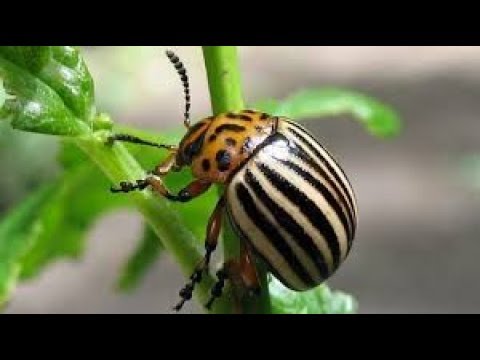

Watch this video on YouTube
Colorado potato beetle remedies
- Actellic (emulsion concentrate 50%). It is a broad spectrum insecticidal agent. During the season, they can process the bushes no more than 2 times, while using a solution consisting of 1 liter of water and 1.5 grams of the product, this amount is enough to process 10 square meters of plantings.
- Arrivo (emulsion concentrate 25%).In comparison with Aktellik, this insecticidal preparation has a wider spectrum of action. During one season, it can also be used no more than 2 times. To prepare the solution, combine 1 bucket of water and 1.5 grams of the product. One liter of solution is enough to spray 10 square meters of plantings.
- Decis (emulsion concentrate 25%). It is an insecticidal preparation of contact action, which, under favorable conditions, is highly effective at a low consumption rate. The agent is not washed off from plants during rain, and when it gets into the ground, it does not accumulate, as it decays. It also interacts with other drugs. The rules for preparing the working solution and consumption per 1 square meter are the same as those of Actellik or Arrivo. It also cannot be used more than twice during the season.
- Inta-VIR tablets... To prepare a solution in 10 liters of water, dissolve 1 tablet. To process 10 square meters of plantings, only one liter of solution is used. During the season, you can spray the bushes with such a solution only a couple of times.
- Kinmix, Karate (emulsion concentrate 5%). These are English insecticidal preparations. To make a working solution, you need to combine 2 grams of Kinmix or 1 gram of Karate with a bucket of water. The funds cannot be used more than twice during the season.
- Sonnet (emulsion concentrate 10%). This is an American insecticidal preparation of contact action; during the season it is sprayed with bushes only once during the mass appearance of larvae. To prepare the solution, combine 1 liter of water with 0.2 grams of the product, this amount is enough to process 10 square meters of plantings.
- Sumi-Alpha (emulsion concentrate 5%). This Japanese insecticide is used no more than 2 times per season. To make a solution, you need to combine 1 bucket of water and 1.5 grams of the product, one liter is enough to process 10 square meters of plantings. The last time you can spray the bushes no later than 4 weeks before harvesting.
- Sumicidin (emulsion concentrate 20%). This Japanese remedy is also used only a couple of times per season. To prepare a solution, combine 1 liter of water and 0.3 grams of the product, this volume is enough to process 10 square meters of plantings.
- Cymbush (emulsion concentrate 25%). This English remedy has a wide range of effects. Use it only 2 times during the growing season, no more. Mix 10 liters of water and 1 gram of the product and spray the bushes, while 1 liter is enough to treat 10 square meters of land.
- Sherpa (emulsion concentrate 25%). This French drug is used just like Cymbush.
- Prestige (suspension concentrate). Such a fungicide-insecticidal preparation from Bayer is used for dressing potato roots. Prestige can also process the bushes of nightshade crops, for this a solution is prepared: combine a liter of water with 10 milligrams of the drug.
- Regent from the Colorado potato beetle. It is a universal insecticidal agent in 1 milligram ampoules. In order to obtain a working solution, you need to combine the contents of one ampoule with 10 liters of water.
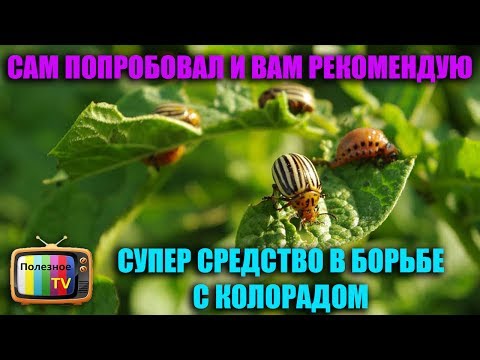

Watch this video on YouTube
Folk remedies
Chemicals are good because they are very effective, but the toxic substances contained in them will still eventually enter the human body. What to do in order not to harm health and save the crop from the beetle? The mechanical method is distinguished by its safety and efficiency, but if you have a whole potato field, then it will be very difficult to collect pests by hand. In this case, folk remedies will help get rid of the pest, which are less effective than chemicals, but they definitely will not harm a person. The most effective folk remedies:
- To prepare the infusion, combine 1 bucket of freshly boiled water and 1 kilogram of green fruits and fresh walnut foliage. Cover the container with a lid, and after 7 days the product will be ready, it will only be necessary to strain it.
- Combine a bucket of very hot water and 300 grams of dried foliage and walnut shells. The mixture, covered with a lid, should stand for 7 days, after which it is filtered.
- A bucket of water is combined with 1 kilogram of dried and crushed white acacia bark. After three days, the finished infusion is filtered.
- Fill a bucket halfway with fresh poplar foliage and add water. Let the mixture boil for a quarter of an hour, then bring the volume of the broth to 10 liters. After three days, the agent is drained and used as directed.
- A liter of water is combined with 10 grams of birch tar, the resulting solution is sprayed with bushes three times within 7 days.
- Ten liters of water is combined with 500 grams of sunflower flowers. After three days, the finished infusion is filtered.
- One and a half kilograms of celandine is combined with very hot water. The product, covered with a lid, should be infused for three hours. The filtered infusion is combined with a solution of calcium chloride (1.5%).
- Fill a bucket with dry or freshly chopped celandine, pour hot water into it and boil the mixture over low heat for a quarter of an hour. The drained broth is used for spraying in a diluted form: for 10 liters of water, 0.5 liters of the product.
- Dry roots of elecampane in the amount of 100 grams are crushed and combined with freshly boiled water, the infusion will be ready after a couple of hours. The first treatment with such an infusion is carried out when the bushes reach a height of about 15 centimeters. Experts advise to spray the bushes with this product three times with an interval of one and a half weeks.
- A bucket of water (temperature from 70 to 80 degrees) is combined with 0.3 kilograms of onion husks. Put a load on top of the mixture and let it brew for 24 hours. After the infusion is filtered.
- Pour 0.2 kg of dandelion herb and the same amount of horsetail into a bucket of water, let the mixture boil for a quarter of an hour. The cooled, strained broth is immediately used to spray the bushes.
- 1 tbsp. wood ash is mixed with 0.3 kg of finely chopped fresh wormwood. Boiling water is added to the mixture and it is left for three hours to infuse, after which it is filtered.
- A liter of water is combined with 10 grams of dry hot pepper. The mixture is boiled for a couple of hours, and after it has cooled down, it is filtered and combined with 4 grams of crushed soap. Stir until the soap is completely dissolved.
- A bucket of warm water is combined with 1 kg of tomato foliage and shoots, which are pre-crushed. After 4-5 hours, filter the finished infusion and mix with 40 grams of crushed soap (stir the product until it is completely dissolved).
- A bucket of water is combined with three kilograms of tomato tops. The mixture is boiled for about 30 minutes. The cooled strained broth must be diluted with water before spraying in a ratio of 1: 5. In this case, each liter of the working solution is combined with four grams of grated soap.
- The dried roots of tobacco in the amount of 0.5 kg are combined with 1 bucket of water and left for a couple of days. The finished strained infusion is diluted with water in a ratio of 1: 2 and mixed with soap.
- A bucket of water is combined with 0.5 kg of finely chopped tobacco shoots or tobacco dust. The infusion will be ready after a couple of days. Before proceeding with the treatment, 1 part of the product is combined with 2 parts of water and soap is added.
- Pour 0.2 kg of finely chopped garlic heads and arrows into a bucket filled with water. The mixture is left for some time to infuse, and then filtered and combined with 40 grams of soap.
It is also quite effective to treat bushes from the beetle with dry means. The best folk remedies:
- Sift the wood ash and dust the bushes with it. It is best to use ash obtained from burning birch for this. Before the plants begin to bloom, they are dusted once every 15 days, and when they have faded, once every 30 days.Processing is carried out in the morning, when there is still dew on the foliage, or after rain. Approximately 10 kilograms of ash are consumed per one hundred square meters.
- Damp foliage can be dusted with cornmeal. It is also a fairly effective pest control method.
- To accurately destroy the beetle larvae, the bushes should be powdered with cement or gypsum.
- The smell of fresh birch or pine sawdust can scare off the beetle. Before the bushes bloom, the sawdust is scattered between them once every half a month, and when they fade - once every 30 days.
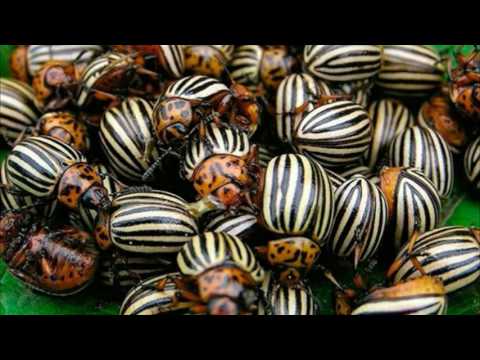

Watch this video on YouTube
How to save nightshade crops from the Colorado potato beetle
Colorado potato beetle
At the very beginning of the spring period, immediately after the soil on the site warms up, you need to choose a cloudy day and scatter potato peelings over the surface of the earth, previously they are kept in a chloroform solution for 24 hours. After a few days, check the cleanings and remove all Colorado beetles that are on them from the area. This will clear the area of a certain part of the pest even before planting potato tubers. This procedure is repeated about 7 days before the shoots appear, and in the autumn after harvesting, but you need to be in time before the insect leaves for winter.
Such a pest can be scared off by the unpleasant aroma of rotting onion husks. In this regard, when planting potato tubers, you need to pour a handful of wood ash into each of the planting holes and put a little onion husk. The beetle will bypass these bushes before they bloom, and after flowering it will no longer be able to seriously harm the potatoes. Also, to protect the plant from the pest, the soil surface between the rows is covered with a layer of straw. In addition to the fact that it inhibits the growth of weeds and prevents the soil from drying out, it also protects potato tubers from direct sunlight and is a favorable environment for the life of certain insects and spiders, which are considered natural enemies of the Colorado potato beetle, for example: ladybugs, ground beetles and praying mantises.
It was also noticed that this insect can be scared away by the smell of some plants, for example: tansy, marigolds, hemp, nasturtium, sage, catnip, calendula, coriander and matthiola. Therefore, these crops are recommended to be grown in the aisles of potatoes, as well as along the perimeter of the site. Thanks to this, the potato will bypass the beetle. But make sure that self-seeding does not occur, therefore, the flowers themselves are plucked or mowed immediately after the appearance or opening.
In addition, you can use various chemical agents, this method has been described in detail above. In recent years, gardeners are increasingly using a new French drug - "Colorado potato beetle NO", it is not dangerous for both animals and people. The main active ingredient of this drug is Indian azadirachta oil. To prevent the appearance of a beetle on potato bushes, you will need 3 treatments with an aqueous solution in a ratio of 1:40:
- processing the planting holes immediately before planting potato tubers;
- during the mass appearance of sprouts;
- half a month after the second treatment.
If you decide to protect potatoes with Prestige, then you should take into account that treating the tubers with it will not save adult bushes from the second wave of the Colorado potato beetle. In this case, you will have to use another foliar spray. When using Bankcol for treating bushes, which very effectively exterminates the pest, it should be borne in mind that it helps to suppress the reproductive function of potatoes. Therefore, if you leave planting material from the treated bushes, then next year it will give a very meager harvest.
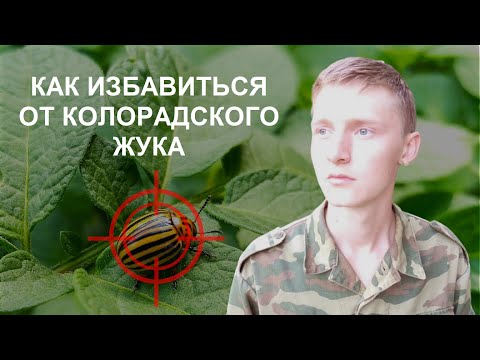

Watch this video on YouTube
Colorado potato beetle on eggplant
You can fight the pest with the help of traps.To do this, at the beginning of the spring, after the soil has just warmed up, peelings or pieces of potato tubers are laid out in several places. After insects accumulate on the pieces of vegetable, they are doused with gasoline and burned. In order to avoid the incineration procedure, the purification is pretreated with Chlorophos, but if you have already used it more than once, then the effectiveness of its use will be very low.
After the ovaries have formed on the eggplants, chemical treatment should be stopped. From this time on, the gardener can only hide the eggplants from insects. Take plastic bottles and cut off the neck and bottom of them, the resulting "tube" must be put on the bush. The fact is that beetles in this period fly extremely rarely, and move more along the ground and climb the bushes along the stem. A kind of "covers" will not let the insect get on the foliage of the eggplant. Some gardeners enclose the bushes with a half-meter fence made of plastic wrap. Since females at this time are too lazy to fly, and males are not attracted to places where there are no females, the landings will be protected, but this will not last long.
You can also protect plants with a mosquito net. From it, with the help of a stapler, a kind of caps are made for each bush. An insect cannot get through such a mesh, but it allows light, air, and moisture to pass through. Do not forget to sprinkle the bottom edge of the net with soil, otherwise it can be carried away by the wind. You can also try to scare off pests; for this, the surface of the site is covered with fresh mowed forbs almost to the height of the plants. The pests do not really like the unusual aroma, and they try to bypass such an area.
If you still find beetles on the bushes, then folk remedies should be used to process them, or you should remove insects from the foliage with your hands. The fact is that it is highly undesirable to use chemicals for spraying eggplants, as they are overly toxic.
Colorado potato beetle on pepper
The beetle rarely settles on bell peppers, but if conditions are favorable, then this may well happen. A pest can leave you without a crop. At the beginning of spring, after the snow cover has melted, do not forget to spread the pieces of potatoes over the area, and then, when the beetles slide down to them, they are collected and destroyed. Do not forget to inspect pepper sprouts every day; if pests are found, they are put in a jar filled with a concentrated salt solution. The safest way to get rid of bugs is by hand picking, but it takes a lot of time and effort. To spray the bushes affected by the Colorado potato beetle, only folk remedies are used, for example: a decoction or infusion of hot pepper, walnut, wormwood, tomato tops, etc.
Colorado potato beetle on tomatoes
Of all the pests, the Colorado potato beetle is the most dangerous for tomatoes. For the purpose of prevention in the autumn, the site intended for planting tomatoes must be dug deeply. In springtime, you also need to remember to lay out the baits (potato pieces) and destroy the pests that have crawled towards them. To protect young seedlings, cylinders made from plastic bottles can be used (see eggplant). A trap in the form of a gutter for young pests is installed around the perimeter of the site, it should be with slopes at an angle of 45 degrees.
Since beetles accumulate toxic substances and alkaloids contained in the shoots and foliage of nightshade crops, many predatory insects and birds will not eat them. Adults can be eaten either by guinea fowls or turkeys, but they need to be taught to do this when they are still very young. To do this, a small amount of crushed insects is added to their feed.
If beetles have nevertheless settled on tomato bushes, then they should be collected by hand. In this case, chemicals cannot be used for processing, and folk remedies will be ineffective. In order for pest control to be more effective, you can pick them by hand, and then process the tomatoes with one of the folk remedies.
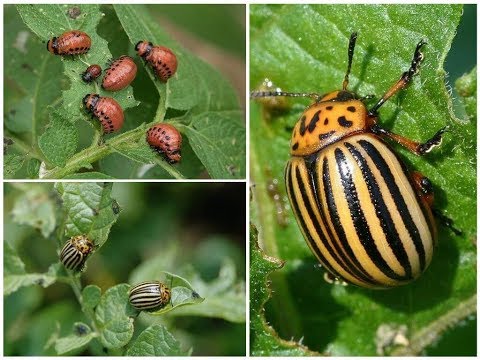

Watch this video on YouTube

